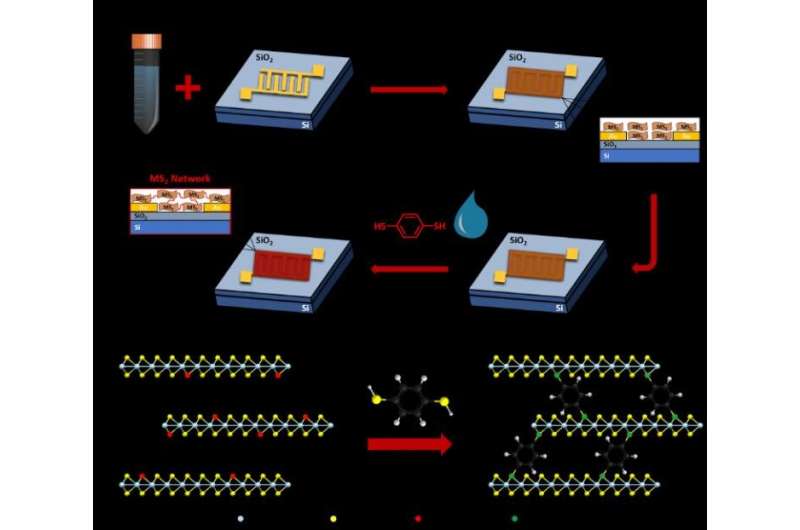Molecular bridges power up printed electronics

The exfoliation of graphite into graphene layers inspired the investigation of thousands of layered materials: amongst them transition metal dichalcogenides (TMDs). These semiconductors can be used to make conductive inks to manufacture printed electronic and optoelectronic devices. However, defects in their structure may hinder their performance. Now, Graphene Flagship researchers have overcome these hurdles by introducing 'molecular bridges,' small molecules that interconnect the TMD flakes, thereby boosting the conductivity and overall performance.
The results, published in Nature Nanotechnology, come from a multidisciplinary collaboration between Graphene Flagship partners the University of Strasbourg and CNRS, France, AMBER and Trinity College Dublin, Ireland, and Cambridge Graphene Centre, University of Cambridge, UK. The employed molecular bridges increase the carrier mobility—a physical parameter related to the electrical conductivity—tenfold.
TMD inks are used in many fields, from electronics and sensors to catalysis and biomedicine. They are usually manufactured using liquid-phase exfoliation, a technique developed by the Graphene Flagship that allows for the mass production of graphene and layered materials. But, although this technology yields high volumes of product, it has some limitations. The exfoliation process may create defects that affect the layered material's performance, particularly when it comes to conducting electricity.
Inspired by organic electronics—the field behind successful technologies such as organic light-emitting diodes (OLEDs) and low-cost solar cells—the Graphene Flagship team found a solution: molecular bridges. With these chemical structures, the researchers managed to kill two birds with one stone. First, they connected TMD flakes to one another, creating a network that facilitates the charge transport and conductivity. The molecular bridges double up as walls, healing the chemical defects at the edges of the flakes and eliminating electrical vacancies that would otherwise promote energy loss.
Furthermore, molecular bridges provide researchers with a new tool to tailor the conductivity of TMD inks on demand. If the bridge is a conjugated molecule—a structure with double bonds or aromatic rings—the carrier mobility is higher than when using saturated molecules, such as hydrocarbons. "The structure of the molecular bridge plays a key role," explains Paolo Samorì, from Graphene Flagship partner the University of Strasbourg, France, who led the study. "We use molecules called di-thiols, which you can readily buy from any chemical supplier's catalog," he adds. Their available structural diversity opens a world of possibilities to regulate the conductivity, adapting it to each specific application. "Molecular bridges will help us integrate many new functions in TMD-based devices," continues Samorì. "These inks can be printed on any surface, like plastic, fabric or paper, enabling a whole variety of new circuitry and sensors for flexible electronics and wearables."
Maria Smolander, Graphene Flagship Work Package Leader for Flexible Electronics, adds: "This work is of high importance as a crucial step towards the full exploitation of solution-based fabrication methods like printing in flexible electronics. The use of the covalently bound bridges improves both the structural and electrical properties of the thin layers based on TMD flakes."
Andrea C. Ferrari, Science and Technology Officer of the Graphene Flagship and Chair of its Management Panel, adds: "The Graphene Flagship pioneered both liquid phase exfoliation and inkjet printing of graphene and layered materials. These techniques can produce and handle large volumes of materials. This paper is a key step to make semiconducting layered materials available for printed, flexible and wearable electronics, and yet again pushes forward the state of the art."
More information: Ippolito, S., Kelly, A.G., Furlan de Oliveira, R. et al. Covalently interconnected transition metal dichalcogenide networks via defect engineering for high-performance electronic devices. Nature Nanotechnology (2021). doi.org/10.1038/s41565-021-00857-9
Journal information: Nature Nanotechnology
Provided by Graphene Flagship





















